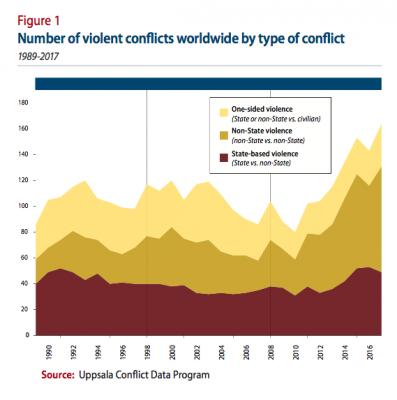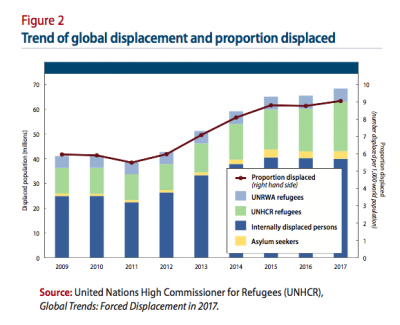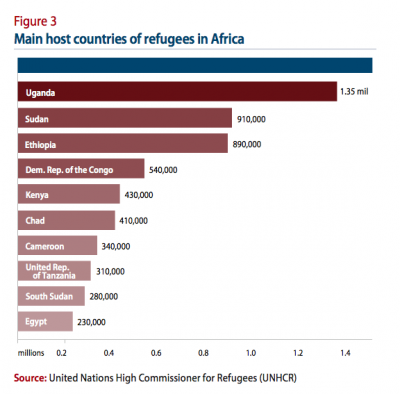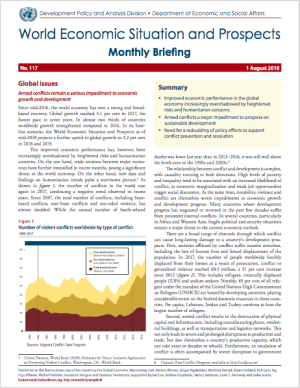- Improved economic performance in the global economy increasingly overshadowed by heightened risks and humanitarian concerns
- Armed conflicts a major impediment to progress on sustainable development
- Need for a redoubling of policy efforts to support conflict prevention and resolution
English: PDF (292 kb)
Global issues
Armed conflicts remain a serious impediment to economic growth and development
Since mid-2016, the world economy has seen a strong and broad-based recovery. Global growth reached 3.1 per cent in 2017, the fastest pace in seven years. In almost two thirds of countries worldwide growth strengthened compared to 2016. In its baseline scenario, the World Economic Situation and Prospects as of mid-2018 projects a further uptick in global growth to 3.2 per cent in 2018 and 2019.
 This improved economic performance has, however, been increasingly overshadowed by heightened risks and humanitarian concerns. On the one hand, trade tensions between major economies have further intensified in recent months, posing a significant threat to the world economy. On the other hand, new data and findings on humanitarian trends paint a worrisome picture. As shown in figure 1, the number of conflicts in the world rose again in 2017, continuing a negative trend observed in recent years. Since 2007, the total number of conflicts, including State-based conflicts, non-State conflicts and one-sided violence, has almost doubled. While the annual number of battle-related deaths was lower last year than in 2013?2016, it was still well above the levels seen in the 1990s and 2000s.
This improved economic performance has, however, been increasingly overshadowed by heightened risks and humanitarian concerns. On the one hand, trade tensions between major economies have further intensified in recent months, posing a significant threat to the world economy. On the other hand, new data and findings on humanitarian trends paint a worrisome picture. As shown in figure 1, the number of conflicts in the world rose again in 2017, continuing a negative trend observed in recent years. Since 2007, the total number of conflicts, including State-based conflicts, non-State conflicts and one-sided violence, has almost doubled. While the annual number of battle-related deaths was lower last year than in 2013?2016, it was still well above the levels seen in the 1990s and 2000s.
The relationship between conflict and development is complex, with causality running in both directions. High levels of poverty and inequality tend to be associated with an increased likelihood of conflict, as economic marginalization and weak job opportunities trigger social discontent. At the same time, instability, violence and conflict are themselves severe impediments to economic growth and development progress. Many countries where development progress has stagnated or reversed in the past few decades suffer from persistent internal conflicts. In several countries, particularly in Africa and Western Asia, fragile political and security situations remain a major threat to the current economic outlook.
There are a broad range of channels through which conflict can cause long-lasting damage to a country?s development prospects. First, societies afflicted by conflict suffer massive atrocities, including the loss of human lives and forced displacement of the population. In 2017, the number of people worldwide forcibly displaced from their homes as a result of persecution, conflict or generalized violence reached 68.5 million, a 51 per cent increase since 2012 (figure 2). This includes refugees, internally displaced people (IDPs) and asylum-seekers. Notably, 85 per cent of all refugees under the mandate of the United Nations High Commissioner on Refugees (UNHCR) are hosted by developing countries, placing considerable strain on the limited domestic resources in these countries. Per capita, Lebanon, Jordan and Turkey continue to host the largest number of refugees.
Second, armed conflict results in the destruction of physical capital and infrastructure, including manufacturing plants, residential buildings, as well as transportation and logistics networks. This not only leads to severe and prolonged disruptions to production and trade, but also diminishes a country?s productive capacity, which can take years or decades to rebuild. Furthermore, an escalation of conflict is often accompanied by severe disruption to government institutions, and a scale down in the provision of social services, such as water, electricity and healthcare, exacerbating already dire humanitarian conditions.
Third, the risk or perceived risk of conflict itself entails economic costs to a country. An elevated risk of violent outbreaks dampens a country?s investment prospects, given that foreign investors place great importance on security and political and macroeconomic stability when making investment decisions. A recent report by the Organisation for Economic Co-operation and Development (OECD) highlighted that in 2016 only 9.3 per cent of total foreign direct investment into countries eligible to receive official development assistance (ODA) reached countries in fragile situations. The lack of long-term sources of external finance makes countries at risk of conflict vulnerable to balance of payment shocks. Weakening investor confidence could trigger large short-term capital outflows and a sharp depreciation in the domestic currency, forcing monetary tightening and stoking inflationary pressures. The resulting abrupt decline in purchasing power could in turn fuel political unrest and social tensions, triggering more widespread conflict and instability.
Fourth, conflict also has significant effects on fiscal positions. Global military expenditure reached $1.7 trillion (2.2 per cent of world GDP) in 2017 and has risen steadily in real terms over the last two decades. This aggregate figure, however, masks stark variation in the military burden of countries. For instance, military spending accounts for less than 2 per cent of GDP in most countries in Latin America and the Caribbean but exceeds 4 per cent of GDP in most Western Asian countries. For many developing economies, high defence and security expenditure diverts scarce public resources away from much-needed investment in infrastructure, health and education, thus undermining progress towards sustainable development.
The outbreak of violent conflict can reverse decades of development progress, and the risk of conflict continues to pose a fundamental obstacle to achievement of the Sustainable Development Goals and the 2030 Agenda for Sustainable Development. In addition to the devastating humanitarian crises, conflict zones and neighbouring regions suffer heavy economic losses. Widespread displacement of populations, destruction of capital and infrastructure, and an extended moratorium on new investment can keep the economies well below pre-conflict production potential for many years, even once a lasting solution is in sight. In 2016, just 2 per cent of total gross ODA went to conflict prevention and associated activities. Policy priorities must include redoubling efforts to support conflict prevention and resolution, in order to rise to the challenge of leaving no one behind.
Developed economies
Europe: Increase in asylum seekers a major political and financial challenge
Migration trends remain a major political, economic and financial issue within the European Union (EU). In 2015, the EU saw a major spike in first-time asylum applications to more than 1.2 million, more than twice as many as in the previous year. The number remained high at more than 1.2 million in 2016, before decreasing to about 650,000 in 2017. In both 2016 and 2017, the most frequent nationalities seeking asylum in the EU included Afghanistan, Eritrea, Iraq, Nigeria, Pakistan and Syria. The main destination countries in absolute numbers in the EU were France, Germany, Greece, Italy, Spain and the United Kingdom.
These migration trends have had a range of consequences. In terms of national and EU-wide security, they have moved the issue of free movement to the fore. One of the core principles of the EU is the freedom of movement of goods, capital, services and labour, and with this the effective abolishment of national borders among those countries that are a member of the Schengen treaty. However, with the sharp increase in the number of asylum seekers and the subsequent question of how and where to grant asylum in the EU, securing the external border of the Schengen area and establishing a working EU-wide mechanism for granting asylum has become a major policy priority. In addition, for the major asylum-granting countries, accommodating and integrating asylum seekers into society and the labour market takes time, and bears short-term fiscal costs. On average across the main reception countries in Europe, the costs for processing and accommodating asylum seekers is estimated at about 10,000 euro per application for the first year.
Economies in transition
Commonwealth of Independent States: Internal and regional conflicts negatively affect economic development
Several internal and regional conflicts in the Commonwealth of Independent States (CIS) area are negatively weighing on development prospects. In Ukraine, around 1.8 million people remain displaced as a result of the conflict in the East of the country since 2014; this is one the largest groups of IDPs in the world. The financial and social support provided to them has been limited. The conflict incurred huge costs on the Ukrainian economy, damaging coal mining and metallurgy industries, export and budget revenues and disrupting transport links and energy supply. The share of the industrial sector in GDP has drastically declined.
Regional conflicts in the South Caucasus have also caused massive displacement of people and flows of refugees; as of 2017, over 612,000 Azerbaijanis and 278,000 Georgians remained internally displaced. Addressing the needs of refugees and IDPs imposes budgetary costs, while the flows of refugees and IDPs have affected urbanization patterns, in some cases straining cities? resources. Infrastructure in Azerbaijan has suffered serious damage, including damage to the irrigation system and water resources, which is negatively affecting the agricultural sector in the conflict-adjacent areas. The conflicts have also affected transportation routes and raised transportation costs, notably for the Nakhchivan exclave of Azerbaijan. The closed border with Turkey, along with exclusion from regional economic integration projects, such as energy pipelines and railways, has imposed serious economic costs on Armenia, limiting trade routes and negatively affecting economic sentiment of foreign investors, deterring potential FDI inflows.
Developing economies
Africa: Conflict resolution and inclusive refugee policies expected to provide economic benefits
On 8 July, Eritrea and Ethiopia declared the end of two decades of dormant hostility between the two countries. From an economic standpoint, Eritrea?s tourism sector stands to gain in the medium term, as flights between the two countries resume and embassies reopen. Investor appetite is also likely to strengthen, especially from China and the Gulf States, but will remain insufficient to cover the country?s large investment needs. The possible lifting of international sanctions that were imposed on Eritrea in 2009 could also boost economic prospects. In addition to new air routes, landlocked Ethiopia will acquire access to two Eritrean ports, providing an alternative to trading goods through Djibouti, which currently manages over 90 per cent of all inbound trade, and Somalia.
While this development represents an opportunity to accelerate development progress in parts of East Africa, many African countries remain in situations of armed conflict, political instability and social unrest. At the end of 2017, the number of refugees originating from African countries stood at 7.3 million, while African countries themselves hosted 6.7 million refugees. The number of IDPs stood at 14.7 million. Many refugees are hosted by neighbouring countries. This can create strains on host countries? domestic resources. Some studies also point to impacts on price levels, particularly price increases in areas close to refugee camps.
 Figure 3 shows the countries in Africa which host the largest number of refugees, topped by Uganda which hosts 1.3 million refugees from neighbouring countries. The Government of Uganda has been struggling to provide essential services to the increasing number of refugees, under severe fiscal pressures. Notwithstanding the international community?s appeal, UNHCR has recently announced that there are significant funding shortfalls, about $470 million, for emergency needs. Nevertheless, the Government of Uganda provides one of the most progressive refugee assistance programmes, including freedom of movement, worker?s rights and access to farmland so that refugees can be engaged in economic activities and become self-reliant. This policy is thought to have created economic benefits for the host communities in the form of increased land productivity and higher consumption. While the situation remains challenging, Ugandan continues to register healthy economic growth, which is forecast to reach 6 per cent in 2018. Uganda exemplifies how high growth can be achieved alongside inclusive policies.
Figure 3 shows the countries in Africa which host the largest number of refugees, topped by Uganda which hosts 1.3 million refugees from neighbouring countries. The Government of Uganda has been struggling to provide essential services to the increasing number of refugees, under severe fiscal pressures. Notwithstanding the international community?s appeal, UNHCR has recently announced that there are significant funding shortfalls, about $470 million, for emergency needs. Nevertheless, the Government of Uganda provides one of the most progressive refugee assistance programmes, including freedom of movement, worker?s rights and access to farmland so that refugees can be engaged in economic activities and become self-reliant. This policy is thought to have created economic benefits for the host communities in the form of increased land productivity and higher consumption. While the situation remains challenging, Ugandan continues to register healthy economic growth, which is forecast to reach 6 per cent in 2018. Uganda exemplifies how high growth can be achieved alongside inclusive policies.
East Asia: Tighter international sanctions to further dampen macroeconomic conditions in the DPRK
Despite some diplomatic progress in recent months, geopolitical tensions on the Korean Peninsula remain high, generating persistent uncertainty in East Asia. A possible escalation of tensions leading to conflict constitutes a major risk to the region?s growth prospects.
For the Democratic People?s Republic of Korea (DPRK), the tightening of international sanctions in December last year is expected to further dampen economic activity. Government revenue will be constrained by the ban on DPRK?s exports of certain products, including coal, iron and textiles. Meanwhile, tighter restrictions on imports of crude oil and refined petroleum will fuel inflationary pressures and disrupt production.
The DPRK?s strong focus on strengthening its nuclear and military programmes has diverted significant resources away from the country?s vast humanitarian and development needs. GDP per capita in the DPRK is estimated at $662 in 2016, which is less than 7 per cent of the world average. The United Nations has highlighted that chronic food insecurity, early childhood malnutrition and nutrition insecurity are widespread in the DPRK, with more than 40 per cent of the total population suffering from undernourishment.
South Asia: Afghanistan?s development outlook remains bleak
The economic outlook for Afghanistan remains extremely fragile, amid the long-standing conflict affecting the country. In the first half of 2018, the number of civilian deaths reached a record high, reflecting a worsening of the security situation. The prolonged high uncertainty in the political environment and significant institutional weaknesses remain major impediments to progress. In addition, the lack of reforms will likely constrain investment in the near term. Consequently, GDP growth remains well below potential, with the economy projected to expand by about 3.0 per cent or less in 2018 and 2019. There are also significant downside risks, including a further deterioration in the security situation, a decline in international aid, and a rise in social tensions resulting from higher unemployment. Against this backdrop, Afghanistan faces immense development challenges, first and foremost in building a solid path towards lasting and sustainable peace.
In addition, the situation of Afghan refugees and the internally-displaced population is of grave concern. The United Nations estimates that there are more than 2.5 million Afghan refugees, mainly in the Islamic Republic of Iran and Pakistan. Since 2016, about 400,000 refugees have returned to the country. Yet, the living conditions remain challenging, with communities facing high unemployment given the lack of job opportunities. Several estimates have shown a rise in unemployment and poverty rates in recent periods, especially in rural areas. There are also expectations that the flow of returning refugees will rise in the near term. In July, Pakistan?s Government allowed nearly 1.4 million registered Afghan refugees to remain in the country by granting another three-month interim extension. This situation emphasizes the need for an adequate targeting of humanitarian and development aid.
Western Asia: More signs of economic stability in Iraq and Syria, but the crisis in Yemen remains dire
More signs of economic stabilization have been observed in Iraq and Syria despite ongoing armed conflict in parts of these countries. Iraq?s fiscal balance has improved with higher oil revenues. According to the 2018 budget that was approved by the parliament in March, the fiscal stance remained neutral with a 3.5 per cent increase in the total expenditures. As revitalizing public service provisions, particularly electricity, is an urgent policy issue, public expenditures are projected to increase significantly through a supplemental budget once a new government is formed.
The Syrian economy had been stabilizing since the appreciation of the Syrian Pound (SYP) in November last year. The stable exchange rate at SYP 438/$ is anchoring the consumer price level. As reconstruction efforts have gained momentum, positive GDP growth is projected for Syria in 2018. However, continuing economic sanctions by the United States and the EU restrict foreign capital inflows and constrain the recovery.
The crisis in Yemen remains dire, amid an escalation of the conflict, worsening food security and deteriorating balance of payments conditions. While occasional transport blockades to the most populous areas in the country are exacerbating the food shortage, the contraction of the agriculture sector has also resulted in a higher dependence on food imports. The stoppage of oil and gas exports has depleted foreign exchange reserves, limiting the country?s imports of basic goods.
Latin America and the Caribbean: Economic woes and violence drive increased outward migration
Amid difficult economic conditions and rampant violence in several countries, the number of refugees and asylum seekers from Latin America has soared in recent years. According to recent UNHCR data, the Bolivarian Republic of Venezuela, El Salvador, Guatemala and Honduras have seen rapid increases in outward migration
since 2013.
With the Venezuelan economy entering its fifth year of recession, the country?s GDP has contracted by more than 30 per cent since 2013. The collapse in economic activity has been accompanied by food and medical supply shortages, rising violence, hyperinflation and a deteriorating labour market. According to IMF projections, the unemployment rate is expected to exceed 30 per cent in 2018. Reliable poverty figures are not available, but a recent study by three Venezuelan universities estimates that the percentage of families living below the poverty line rose from 48 per cent in 2014 to 87 per cent in 2017. The socio-economic downward spiral has led to mass migration of Venezuelans in recent years to neighbouring Brazil and Colombia, and also to Argentina, Chile, Mexico, Peru, Spain and the United States. At times, the magnitude of this migration crisis has overwhelmed the infrastructure and administrative capacities, especially in border cities.
In El Salvador, Guatemala and Honduras, widespread poverty, lack of economic opportunities and rampant violence are the main factors driving increased migration to Mexico and the United States. The total number of new asylum seekers originating from the three countries increased from about 15,000 in 2013 to 130,000 in 2017. Over the past decade, per capita GDP in the three countries has grown by an average of 0.9?1.3 per cent per year?rates that are insufficient to reduce poverty significantly and improve employment prospects. At the same time, violence has reached alarming levels. El Salvador and Honduras have the highest rates of intentional homicide in the world, with Guatemala ranked tenth.
The socio-economic crisis in Nicaragua has deepened in recent weeks. Anti-government protests, which erupted in April in response to the Government?s attempt to implement social security reforms, continue. The violent unrest and the political uncertainty have a severe impact on economic activity, and growth projections for 2018 will be reduced considerably.
 Welcome to the United Nations
Welcome to the United Nations
